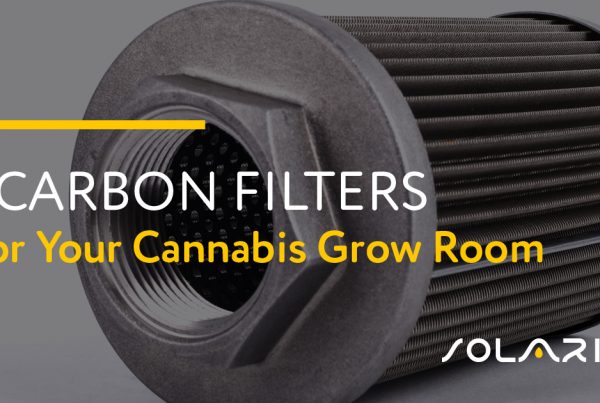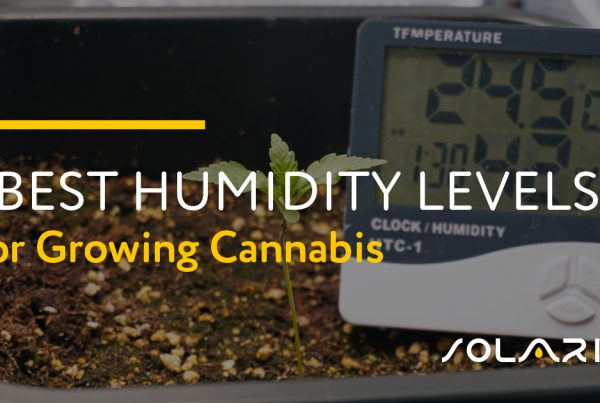The cannabis plant has several structures, many of which we can find on any ordinary flowering plant species. Cannabis grows on long skinny stems with its large, iconic fan leaves extending out from areas called nodes.
Although the flowers get most of the attention, every part of this complex species has a critical and interesting function. As a cultivator, it helps to familiarize yourself with the anatomy of the cannabis plant. In doing so, you will develop an eye for what your plant requires, what it needs less of, and when to harvest.
Seeds
Seeds are produced in female cannabis plants and carry the genetics of a male and female. Seeds need to germinate to sprout and will grow a taproot, which will become the main root that anchors the plant.
Cannabis seeds form within the flowers, beginning life inside a teardrop-shaped casing known as a hairy bract. This casing opens upon maturity and reveals a solid brown seed ready to be dispersed.
The hairy bract keeps cannabis seeds safe until they are ready to be displaced from the flower. Growers need to keep their plants well-watered and fed during this time.
Only harvest seeds when they are fully mature. Younger seeds appear small and light beige. Older seeds are large, dark brown, and often feature a striped pattern. Remove the seeds by hand and store them in an airtight bag or mason jar.
Roots
The roots grow down from the main stalk of the plant into the soil. When growing from a seed, the main root is called the “taproot.” Roots are the lifelines of a cannabis plant, pulling water and oxygen into the plant so it can grow healthy and strong.
The roots also act as a communication platform through which plants can dictate the microbial world of the rhizosphere. The roots do not just take up free-floating nutrients from the soil. Many nutrients are locked up in organic matter. They need beneficial organisms (bacteria, fungi, worms) to liberate these molecules.
Plants create sugars during photosynthesis, and a lot of these sweet chemicals are released into the rhizosphere by the roots. These sugars attract bacteria that linger around the root zone. After they perish, the bacteria release liberated nutrients that roots can now uptake. Growers often face issues with roots when it comes to watering. Overwatering leads to poor water and nutrient uptake and root rot. Underwatering will starve your plants as they attempt to transport nutrients.
As a general rule of thumb, place your finger into the soil to assess its moisture level. Only water your cannabis plants once the top 3cm of soil is completely dry. You can also care for roots by utilizing air pruning. By growing cannabis in fabric pots, you will help your plants develop a dense and aerated root mass.
Cannabis plants become root-bound when they are left to grow in a small container. This can lead to nutrient deficiencies and unsteady, underdeveloped plants. Always make sure to transplant on time and up-pot to the right size.
Roots are not alone in the soil. They share their home with millions of microbes. Although some of these are friendly, others can wreak havoc. Pythium, a root pathogen, can attack roots and even kill entire plants. As such, you will want to learn how to keep your growing medium free of the disease.
Cotyledon leaves
These are the first leaves to grow from the seed after germination. They usually come in pairs, although sometimes they arrive as triplets. Seeing them is a sign of successful germination and that your plant is on its way to growing healthy and strong.
Eventually, the first true leaves will emerge from the middle of the cotyledons. As the plant matures, the cotyledons will turn yellow, die, and drop off onto the soil below.
Stem
The main stem of a cannabis plant grows straight up from the root system and supports all lateral branches. The stem gives a plant structure and stability. The stem also contains xylem, water-carrying tissue that starts in the roots and extends into all areas of the plant.
Cannabis stems are rigid, sturdy, and can become quite large. Some larger sativa strains develop a longer stem that looks more like wood than soft plant tissue.
Growers often top plants and create two main stems through techniques such as main-lining. Other methods, such as low-stress training (LST), manipulate the stem to grow parallel to the ground, causing each branch to surge upwards. Training the stem comes with many benefits, including enhanced productivity, light exposure, and aeration.
Cannabis stems actually contain a small amount of cannabinoids. You can use stems to make
- Concentrates
- Teas
- THC butter
- Cannabis liquor
Branches
Branches grow out of the main stem and support fan leaves to conduct photosynthesis and the weight of its buds. Just like stems, growers can train branches to increase yield and improve the overall structure of the plant. Super cropping helps growers achieve these results, but the technique can be quite risky at times.
Branches contain a low cannabinoid count and share a similar texture to stems. Use them in the same way as stems to produce teas, extracts, and even mulch.
Node
A node is a point at which a branch grows off of the main stem, or one branch from another branch. Fan leaves and buds can grow on some nodes, but not necessarily all.
When determining the sex of a cannabis plant, pre-flowers, or the beginnings of male and female sex organs, will appear at the nodes. The space between nodes is called “internodal spacing” and will give you a sense of whether a plant will grow tall or short.
Fan leaves
Fan leaves are the large, iconic leaves of the cannabis plant. They capture light for the plant and also possess small openings known as stomata that assist with transpiration and carbon-dioxide uptake. Fan leaves are positioned along all of the branches that shoot off from the main stem.
Cannabis fan leaves differ depending on the morphology of a particular strain. Sativa-dominant strains tend to possess fan leaves with nine thin fingers. Indica leaves often feature seven much broader fingers. Ruderalis plants feature small fan leaves with only five fingers, two of which are much smaller and reside near the leaf’s stem.
Experienced growers count on fan leaves to communicate the health status of their plants. Discoloration and wilting or curling can let growers know which nutrients are missing, or if a plant is being watered enough.
The removal of fan leaves, known as defoliation, is common in the training regime of many growers. Taking away unnecessary fan leaves improves aeration, increases light exposure, and cuts mold risk.
Fan leaves contain a small amount of cannabinoids and can be used to make:
- Hash
- Extracts
- Tinctures
- Teas
- Raw smoothies
- Salads
Sugar leaves
Sugar leaves are the small, resin-coated leaves that buds form around. Sugar leaves are usually saved as “trim” during harvest and can be used for cannabis products. Acting as biological solar panels, sugar leaves also conduct photosynthesis. They grow out of mature flowers and serve as a localized sugar production site.
Sugar leaves got their name from the frosty, sugar-like coating that occupies their surface. The trichomes responsible for this glistening aesthetic produce impressive levels of cannabinoids, not as much as the flowers, but more than any other part of the plant. After trimming your flowers, you can use sugar leaves to make:
- Concentrates
- Cannabis-infused oils and butter
- Kief
Flowers
Also known as “buds,” the flowers of a cannabis plant are the fruits of your labor. They contain cannabinoids and terpenes that get you high and offer many health benefits. Flowers only grow on female cannabis plants and must be dried before consumption. They possess a structure that, when fertilized by pollen, begins to form seeds.
Male plants do not produce flowers. Instead, they churn out pollen sacs that split open and disperse pollen into the air. When this substance lands on female flowers, they will become fertilized and begin to form seeds.
Cannabis flowers form at the nodes of stems and branches. The flower is incredibly versatile and can be used in ways such as:
- Smoking
- Vaping
- Extracts
- Oils
- Edibles
- Teas
Cola
A cola, also called a “bud site,” refers to a cluster of buds that grow tightly together. While smaller colas occur along the budding sites of lower branches, the main cola (sometimes called the apical bud) forms at the top of the plant.
Bract and calyx
On the cannabis plant, the bracts are where the flowering buds develop. Bracts are designed to protect the flower and bud, but on the cannabis plant, the flower itself is also considered a floral bract, which leads to some confusion.
The entire flower of the cannabis plant is a leaf-like tubular design that produces capitate-stalked glandular trichomes to attract pollinators. From the flower’s glandular structure, a pair of stigma grows. Bracts contain high concentrations of trichomes. Though often confused with bracts, the calyx is a translucent layer at the flower’s base and is not visible to the naked eye.
Stigma and pistil
The pistil contains the reproductive parts of a flower, and the vibrant, hair-like strands of the pistil are called stigmas. Stigmas serve to collect pollen from males.
The stigmas of the pistil start a white color and progressively darken to orange, red, or brown throughout the plant’s maturation. They play an important role in reproduction, but stigmas bring very little to the flower’s potency and taste.
Trichomes
Despite their minute size, it is hard to miss the blanket of crystal resin on a cannabis bud. This resin is secreted through translucent, mushroom-shaped glands on the leaves, stems, and calyxes. Plants originally developed trichomes to protect against predators and the elements.
Trichomes are busy producing abundant supplies of the more than 400 compounds that comprise the chemical profiles of cannabis plants. They perform this activity with extraordinary proficiency, creating impressive amounts of the essential cannabinoids, terpenes, and flavonoids that cannabis and hemp harvesters, manufacturers, and consumers covet.
Trichomes rely on color to signal when their biochemical activities are complete. Cannabis and hemp cultivators track the progress of the trichome “factories” based on their color changes, timing their harvesting activity to ensure maximum yield in quantity and quality.
As their life cycle and production cycle progresses over a few weeks, trichomes will transform from translucent to cloudy white, and finally to a rich amber hue. When they rich this color it is time to harvest.


